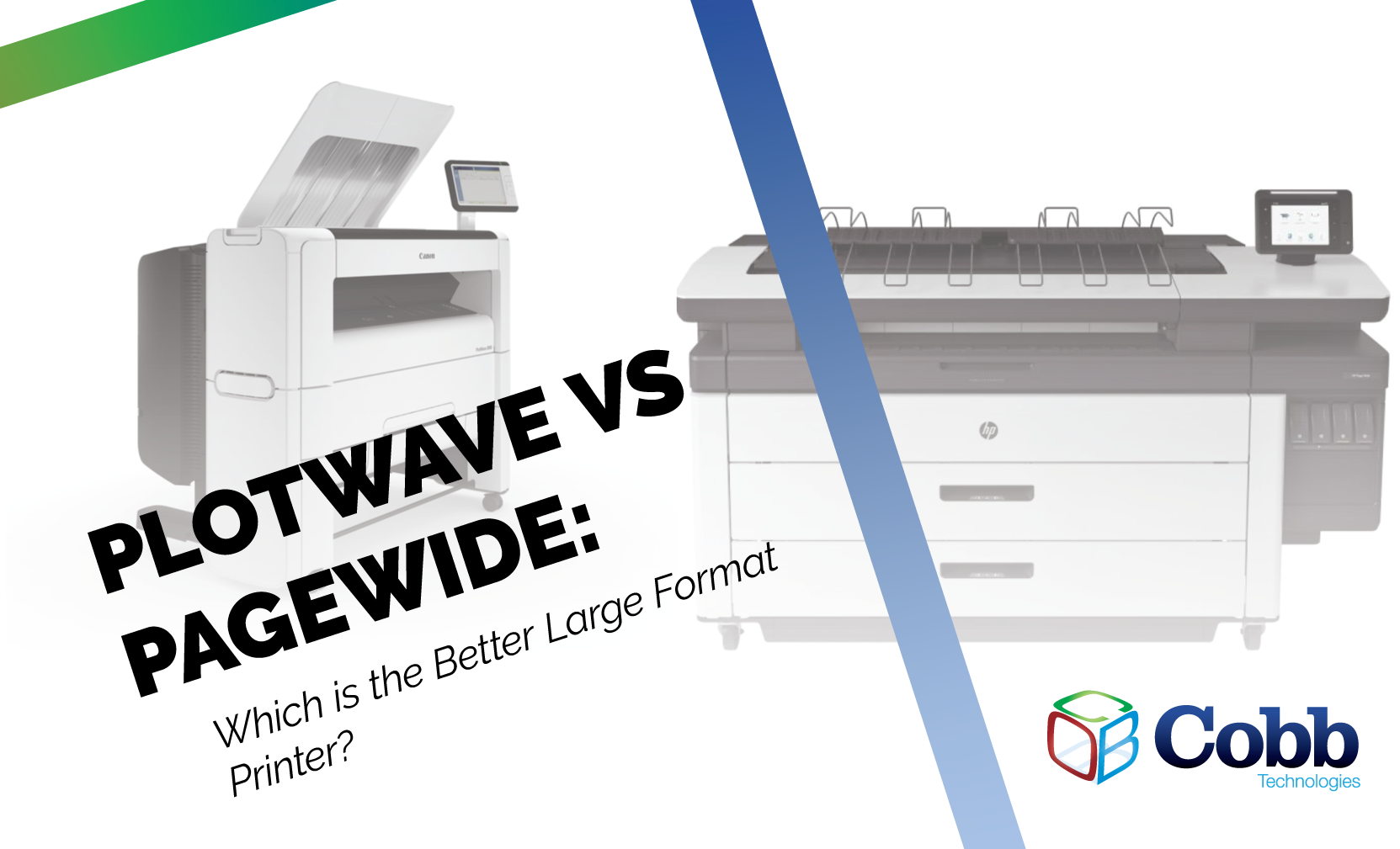3 min read
Building Culture That Works: Cobb Tech Named One of VA's Best
Cobb Technologies has been honored as one of the 2025 Best Places to Work in Virginia by Virginia Business and Best Companies Group. This prestigious...
3 min read
 Tim Kitchen
Oct 11, 2022 1:01:11 PM
Tim Kitchen
Oct 11, 2022 1:01:11 PM

A large-format printer can be the difference between having blueprints to complete a day of work at a site, or missing a day of work because you don’t have updated drawings.
It’s due to this convenience that many businesses rely on their large-format printers to give them the ability to quickly adjust to client requests or design changes.
Before making a decision about which large-format printer is right for you, however, it’s important to know which would be best for you. That’s why we’ve created this blog to compare two of the leading large-format models on the market today: Canon’s PlotWave, and HP’s PageWide XL.
The Canon PlotWave is a black and white printer with an optional color scanner. The entry level models, the 3000 and 3500, have page speeds of 4D sized prints per minute, and 6D sized prints per minute, respectively.
Canon’s PlotWave models are great machines, with a proven track-record in the most demanding environments. Each of the entry level models has a capacity for two rolls and can print up to 36 inches wide. Due to this, it is very popular with sub-contractors, and other businesses that don’t need to print color. It is also a very reliable machine — we partner with clients that print 500 square feet per month on their Canon PlotWaves, and other clients that print 15,000 square feet per month, exemplifying its ability to fit into a wide range of use cases. The Canon PlotWaves use a patented “radiant fusing” technololgy that allows the system to provide immediate printing capability, even from a power saving mode, with no warm-up time. A very handy feature in lower volume environments.
They are also inexpensive to print on, as they are black and white printers, and compare favorably to any other black and white machine on the market. An entry level Canon PlotWave can cost between $12,000 to $19,000, depending on options. On average, if you enhance your Canon PlotWave with a service plan, you can expect your service provider to charge you anywhere from $80 to $100 per month for parts, supplies, and service at entry level volumes.
On average, the cost to run a Canon PlotWave is about eight to ten cents per square foot, meaning owning and operating a PlotWave can result in a favorable comparison to outsourcing your prints to a print shop.
The HP PageWide XL is a full color printer that comes standard with a color scanner. The entry level model, the HP PageWide XL 4200, prints at a speed of 10D’s per minute, making it faster than the entry level Canon PlotWave, even when printing in full color. In addition to this, the PageWide XL 4200 can hold two or four rolls, giving it a greater capacity than the Canon PlotWave.
The PageWide XL is a bigger machine, however, both in footprint and weight with the PlotWave coming in at about 500 pounds, while the PageWide XL weighs twice that, at 1000 pounds. The PageWide XL has the capability to print on a 40-inch roll, wider than the Canon PlotWave, but due to industry standards is not used often for technical drawings. However, the 40” width can be very useful for other applications such as posters or maps.
The PageWide XL has proven to be a very reliable system. Being an ink-based process, the PageWide XL uses completely different technology than the PlotWave to power its operations. and uses pigment ink, rather than toner, giving it the same resilience as toner, and prints made on the PageWide XL, despite being ink-based, come out dry. Since no heat is used in the printing process of the PageWide XL, power usage is lower than for the Canon PlotWaves.
A huge advantage of the PageWide XL technology is that printing on the PageWide XL, even in color, will cost around the same as black and white prints. Service costs between the PlotWave and PageWide XL are also comparable. However, the basic PageWide XL entry model starts at around $25,000, making it more expensive up front than the PlotWave.
Like the PlotWave, the PageWide XL has no warmup time, but has a slightly longer first page out time than the Canon PlotWave.
One of the best benefits of the PageWide is that it is a family of machines; the 4200 can print up to 10 D-sized prints per minute, the 5200 can print up to 20 per minute, and the 8200 can print up to 30 per minute. As an added benefit, all of these models use the same technology and parts, meaning that the entry level models provide the same high reliability of the higher speed models that are meant to produce more volume.
Overall, the HP PageWide XL is the most popular choice in the industry today, due to its flexibility, high print speeds, color capability, and reliability. However, the lower initial cost for the Canon PlotWave is a very attractive option for those customers that do not require color printing.
With very similar service costs, however, over time, the difference in cost between the PageWide and PlotWave starts to shrink. With both models not really experiencing parts or supply shortages during shipping delays, it truly comes down to if you can see color-printing in your future. In terms of reliability, both machines are fantastic workhorses that will get the job done when you need it done.
To learn more about Large Format, visit our Large Format service page.

3 min read
Cobb Technologies has been honored as one of the 2025 Best Places to Work in Virginia by Virginia Business and Best Companies Group. This prestigious...

5 min read
Cobb Technologies is honored to hold the SWaM (Small, Women-owned, and Minority-owned Business) certification, awarded by the Commonwealth of...

5 min read
Every year, thousands of Veterans transition from military service to civilian careers in Virginia, bringing invaluable skills and experiences to...